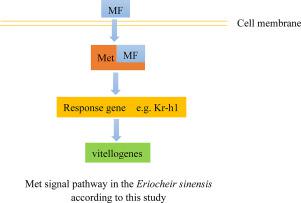Comparative Biochemistry and Physiology B: Biochemistry & Molecular Biology ( IF 1.9 ) Pub Date : 2020-10-24 , DOI: 10.1016/j.cbpb.2020.110524 Xilei Li , Tiantian Chen , Yang Han , Mengting Huang , Hucheng Jiang , Jiawei Huang , Minhui Tao , Ruihan Xu , Qiming Xie , Shiping Su

|
Methoprene-tolerant (Met) belongs to the basic helix-loop-helix (bHLH)-Per-Arnt-Sim (PAS) family of nuclear transcriptional regulators and is a leading candidate receptor for juvenile hormone (JH III) in insects. Methyl farnesoate (MF) is a de-epoxide form of JH III that regulates many developmental processes in crustaceans, including reproduction, molting, and morphogenesis, much like JH III in insects. In this study, the full-length cDNA for Met was cloned from the Chinese mitten crab (Eriocheir sinensis) (EsMet). The amino acid sequence of EsMet contains three conserved domains (bHLH, PAS-A, and PAS B) characteristic of the bHLH-PAS family, having six conserved amino acid residues specifically responsible for JH or MF binding. Tissue distribution analysis revealed that EsMet mRNA is highly expressed in the hepatopancreas. In addition, EsMet and EsVg expression in the hepatopancreas were found to be significantly increased in early endogenous vitellogenic oocytes (stage II) during ovarian development, and the hemolymph MF titer was significantly increased in late exogenous vitellogenic oocytes (stage III), indicating that EsMet is involved in vitellogenesis regulation. In vitro, MF addition markedly upregulated EsMet and EsVg expression in hepatopancreatic tissue, but only EsVg was induced in ovarian tissue. In vivo, EsMet and EsVg expression in the hepatopancreas were both significantly and synchronously increased after MF injection, but not in the ovaries. In addition, EsMet and EsVg expression were upregulated in the hepatopancreas after eyestalk ablation, while only EsVg expression was induced in the ovaries. Thus, our results indicate that Met may act as a receptor for MF in MF-mediated vitellogenesis in crustaceans.
B) characteristic of the bHLH-PAS family, having six conserved amino acid residues specifically responsible for JH or MF binding. Tissue distribution analysis revealed that EsMet mRNA is highly expressed in the hepatopancreas. In addition, EsMet and EsVg expression in the hepatopancreas were found to be significantly increased in early endogenous vitellogenic oocytes (stage II) during ovarian development, and the hemolymph MF titer was significantly increased in late exogenous vitellogenic oocytes (stage III), indicating that EsMet is involved in vitellogenesis regulation. In vitro, MF addition markedly upregulated EsMet and EsVg expression in hepatopancreatic tissue, but only EsVg was induced in ovarian tissue. In vivo, EsMet and EsVg expression in the hepatopancreas were both significantly and synchronously increased after MF injection, but not in the ovaries. In addition, EsMet and EsVg expression were upregulated in the hepatopancreas after eyestalk ablation, while only EsVg expression was induced in the ovaries. Thus, our results indicate that Met may act as a receptor for MF in MF-mediated vitellogenesis in crustaceans.
中文翻译:

甲氨蝶呤(Met)在中华绒螯蟹(Eriocheir sinensis)中的法呢酸甲酯介导的卵黄发生中的潜在作用
甲氨蝶呤耐受(Met)属于核转录调节因子的基本螺旋-环-螺旋(bHLH)-Per-Arnt-Sim(PAS)家族,是昆虫中幼体激素(JH III)的主要候选受体。法尼酸甲酯(MF)是JH III的一种脱环氧化物,可调节甲壳类动物的许多发育过程,包括繁殖,蜕皮和形态发生,就像昆虫中的JH III一样。在这项研究中,从中华绒螯蟹(Eriocheir sinensis)(EsMet)克隆了Met的全长cDNA 。EsMet的氨基酸序列包含三个保守域(bHLH,PAS-A和PAS B)bHLH-PAS家族的特征,具有六个保守的氨基酸残基,专门负责JH或MF结合。组织分布分析表明,EsMet mRNA在肝胰腺中高表达。此外,在卵巢发育过程中,早期内源性卵黄卵母细胞(II期)的肝胰腺中EsMet和EsVg表达显着增加,晚期外源性卵黄卵母细胞(III期)的血淋巴MF滴度显着增加,表明EsMet参与卵黄发生调节。在体外,MF添加明显上调EsMet和EsVg在肝胰腺组织中表达,但在卵巢组织中仅诱导EsVg。在体内,注射MF后,肝胰腺中EsMet和EsVg的表达均显着且同步增加,而卵巢中则没有。此外,眼球消融后肝胰腺中EsMet和EsVg表达上调,而卵巢中仅诱导EsVg表达。因此,我们的结果表明,Met可能在甲壳动物的MF介导的卵黄发生中充当MF的受体。
B)bHLH-PAS家族的特征,具有六个保守的氨基酸残基,专门负责JH或MF结合。组织分布分析表明,EsMet mRNA在肝胰腺中高表达。此外,在卵巢发育过程中,早期内源性卵黄卵母细胞(II期)的肝胰腺中EsMet和EsVg表达显着增加,晚期外源性卵黄卵母细胞(III期)的血淋巴MF滴度显着增加,表明EsMet参与卵黄发生调节。在体外,MF添加明显上调EsMet和EsVg在肝胰腺组织中表达,但在卵巢组织中仅诱导EsVg。在体内,注射MF后,肝胰腺中EsMet和EsVg的表达均显着且同步增加,而卵巢中则没有。此外,眼球消融后肝胰腺中EsMet和EsVg表达上调,而卵巢中仅诱导EsVg表达。因此,我们的结果表明,Met可能在甲壳动物的MF介导的卵黄发生中充当MF的受体。











































 京公网安备 11010802027423号
京公网安备 11010802027423号